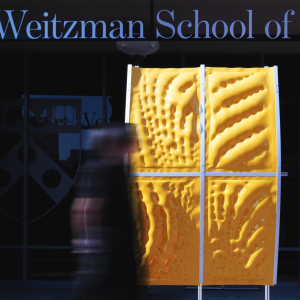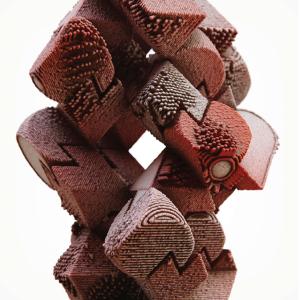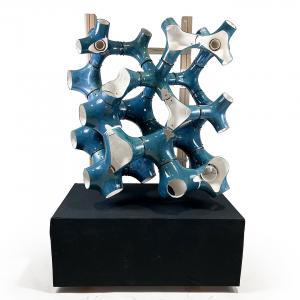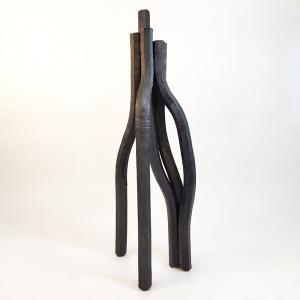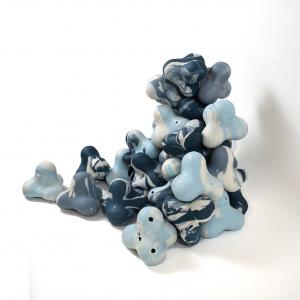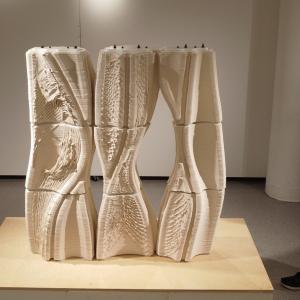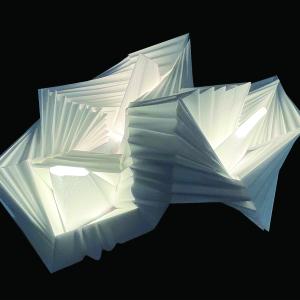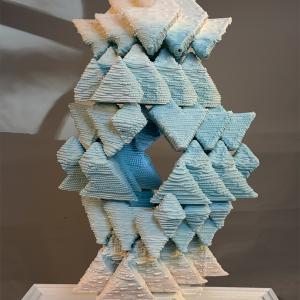Ready to take on new challenges and break into exciting, cutting-edge fields?
Transform your career by positioning yourself at the forefront of innovation in robotics, fabrication, and design-computation.

Join our one-year Master of Science in Design: Robotics and Autonomous Systems (MSD-RAS) program at the University of Pennsylvania Stuart Weitzman School of Design, and obtain a post-professional STEM degree exploring architectural design through AI and robotic fabrication.
Program Overview
The MSD-RAS aims to develop novel approaches to the design, manufacture, use, and life-cycle of architecture through creative engagement with robotics, material systems, and design- computation.
Students will gain skills in advanced forms of robotic fabrication, simulation, and artificial intelligence, in order to develop methods for design that harness production or live adaption as a creative opportunity. During the program, robotically manufactured architectural prototypes (part or whole) are developed by students and presented and exhibited at the completion of three design courses.
WHO IS MSD-RAS FOR?
- Students who already hold a first professional degree from an accredited design program in architecture.
- Post-graduate students or those who have completed equivalent programs of study in related professional fields who can demonstrate their ability to complete the required course of study.
- Professionals who have worked for several years and are seeking advanced study and credentials in robotic fabrication and artificial intellgience (AI) computational approaches to design and production.
Program Goals
The MSD-RAS program will enable graduates to:
- Gain state of the art robotics, AI, material fabrication, and design-computation qualifications.
- Develop skills in advanced methods of fabrication, computation, robot programming and multi-modal sensing technologies, and their integration within innovative design methods.
- Expand career opportunities and options to work in ambitious and diverse fields.
- Impact the present and future trajectory of architecture through novel forms of production, practice and entrepreneurship.
- Operate at the forefront of industry research and development
Why Robotics in Architecture?
The fourth industrial revolution (Industry 4.0) describes a recent shift towards autonomous systems, and societal reliance on cyber-physical processes that incorporate digital communications and navigation infrastructure, robotic manufacturing, and artificial intelligence. The building industry is currently undergoing transformation through the adoption of robotics technologies such as additive manufacturing systems that enable a reduction in the time, cost and complexity of delivering buildings, that also have potential humanitarian and socio-economic benefits. Adoption of these technologies also enables greater automation not only in production but also in design, challenging existing modes of architectural practice. The MSD-RAS program explores avenues for re-situating the role of architectural design within present day autonomous technologies, with the aim of expanding societal and creative design opportunities by leveraging robotic and material processes within design.
Fostering Innovative
Career Trajectories
The MSD-RAS program aims to empower graduates to operate at the forefront of industry research and development, by gaining state of the art robotics, AI, material fabrication, and design-computation qualifications, and to graduate as highly skilled professionals, capable of impacting the present and future trajectory of architecture and industry through novel forms of production, practice and entrepreneurship.
Whether you're looking to advance your career, transition to new industries, start your own company, or pioneer an emerging field, the MSD-RAS program offers hands-on experience with ground-breaking technology and world-class qualifications to help you achieve your goals.
Projects
Curriculum
The MSD-RAS Program includes the following courses:
Summer
- Introduction to 3D Programming & Machine Learning
- (2 week course prior to start of Fall Semester)
Fall
- ARCH 801 Material Agencies: Robotics & Design Lab I (2 CU)
- ARCH 803 Algorithmic Design & Robotic Fabrication (0.5 CU)
- ARCH 805 Introduction to Cyber-Physical Systems (0.5 CU)
- ARCH 807 RAS Theory (1 CU)
- Designated Elective (Within Architecture + Engineering)
Spring
- ARCH 802 Material Agencies: Robotics & Design Lab II (2 CU)
- ARCH 804 Advanced RAS Programming (1 CU)
- ARCH 806 Experimental Tooling (1 CU)
- ARCH 808 Scientific Research and Writing (1 CU)
Total Course Units: 10
Course Descriptions
- Introduction to 3D Programming & Machine Learning
- Designated Elective
- ARCH 801 Material Agencies: Robotics & Design Lab I
- ARCH 802 Material Agencies: Robotics & Design Lab II
- ARCH 803 Algorithmic Design & Robotic Fabrication
- ARCH 804 Advanced RAS Programming
- ARCH 805 Introduction to Cyber-Physical Systems
- ARCH 806 Experimental Tooling
- ARCH 807 RAS Theory
- ARCH 808 Scientific Research & Writing
An Innovative New Program — What Makes the Weitzman School MSD-RAS Unique?
Located in the Stuart Weitzman School of Design – a global leader in architectural design, the MSD-RAS offers a unique education in architectural design and robotic fabrication. The MSD-RAS program offers opportunities for hands-on experimentation, design speculation, team- based collaboration, and access to world-leading facilities, with learning supported primarily through project-based work rather than through a written thesis alone.
The program’s emphasis on project-based work provides practical learning opportunities, also supported by technical and theoretical courses that run in parallel and are directly related to design projects, ensuring participants learn how to approach design from multiple creative and technical aspects holistically, while learning how to communicate design-research to industry and academia. As the MSD-RAS operates within the context of a large, Ivy League, research institution, there are also overlapping interests with the departments of mechanical engineering, computation science,
material science, biology, and medicine that enable opportunities for interdisciplinary collaboration, or participation in seminal interdisciplinary research and symposia.
The MSD-RAS operates from state-of-the-art facilities, such as the Weitzman School ARI Robotics Lab, and has close ties to the building industry. The program’s STEM status, renowned faculty, and proximity to prospective employers in Philadelphia and New York City also ensure it offers the best industry and employment opportunities for graduates. Graduates have pursued several different career trajectories ranging from working with world-leading companies in architectural practice, fabrication, construction and volumetric design-build companies, to tech start-ups. Many graduates also go on to PhD or lecturer positions in academia.
World-leading,
Inter-Disciplinary Faculty
The MSD-RAS program is taught by some of the Weitzman School’s most inter-disciplinary and internationally-experienced architecture faculty, while drawing on expertise from Penn Engineering and Computer Science departments to contribute expert knowledge in robotics, computer vision, electrical engineering, and more.
Penn’s faculty are actively working on research and practice projects related to the core topics of the MSD-RAS, such as a full-scale precast concrete house prototype in collaboration with Cemex that leverages robot hot-wire cutting for the production of formwork molds, a robot curve-folded sheet-metal installation undertaken in collaboration with Robofold, or an advanced environmentally performative cooling-oculus skylight, fabricated using thermo-adaptive robot sheet metal-forming.
Facilities – The Advanced Research and Innovation Robotics Lab
MSD-RAS students utilize Penn’s ARI Robotics Lab facility that houses state-of-the-art industrial robots and experienced staff. The facility includes several ABB and UR robots and provides a flexible production space for individual and team-based robot production. Considerable investment in auto-tool changing capabilities enables an extensive range of production activities to be undertaken with minimal set-up time such as robotic milling, additive manufacturing, sheet-metal bending, or robot hot-wire cutting. The Robotics Lab also houses several high-performance 3D printers, pre and post-production work spaces and equipment for supporting fabrication and robot tooling development, such as a large cubical kiln. Students in the MSD-RAS are trained to utilize industrial robots and other equipment, and it is expected that a considerable amount of their design-research is developed through robotically fabricated prototypes and the development of robot programs and/or end-effector tools.
Course Descriptions
Introduction to 3D Programming & Machine Learning
Contemporary Architectural Design has been radically redefined in the last couple of decades through a series of advances in algorithmic design, robotic fabrication and deep learning (AI). Computation, digital media, and fabrication have shifted fundamental methods of conception, drawing, modeling and construction in architecture. Algorithmic tools are often at the intersection of different disciplines allowing for novel domains of interdisciplinary research. This course provides a foundation for computational design with both generative and procedural (parametric) approaches to 3D design being explored in addition to a basic introduction to robot programming and machine learning. In addition to live-instruction an assignment is undertaken during the course that helps learned knowledge to become tacit knowledge. The specifics of the assignment and tutorials varies per year as do learning objectives.
In principle, however, participants develop an introductory understanding of computational goemetry, generative design, and robot programming.
Course Descriptions
Designated Elective
Students may enroll in available designated electives within the schools of Architecture and Engineering.
Course Descriptions
ARCH 801 Material Agencies: Robotics & Design Lab I
The Fall Material Agencies course consists of two half-semester design-fabrication sections, supported by two aligned Core Technical Seminars of half-semester length each. Students will typically work in pairs. Design discourse and subject matter for these sections varies, but is intimately related to a robotic fabrication research such as:
- Example Section: Sculptured Matter investigates the sculptural and manufacturing possibilities of robot hot-wire cutting. An extension of mathematical and artist driven surface production will be explored that leverages robot motion and geometry in order to produce exemplary robotically fabricated works.
- Example Section: Manipulative Matter explores robot manipulation-based manufacture (Eg. Sheet-metal folding) of prototypical building/sculptural parts. Sheet-metal folding requires computational modelling for geometric and fabrication rationalization in order to ensure designs can be realized by manipulating sheet material without it tearing.
- Example Section: Woven Matter aims to unify design and production within one creative process. The course commences with the development of novel programs to control the motion of Penn’s industrial robots for robotic weaving. 3D design models will be developed in parallel to fabrication experiments and digital simulations.
Course Descriptions
ARCH 802 Material Agencies: Robotics & Design Lab II
The Spring Material Agencies semester-long design course demands a critical and creative response to the role of design within the domain of autonomous manufacturing and Industry 4.0. While the subject matter varies, the course centers on the demonstration of a robotically manufactured prototype that operates as a full-scale part or whole of a design proposal for a building, space, or event. Working in small groups, participants will develop designs for a speculative project-driven scenario explored within computer simulations and other forms of design media in addition to a fabricated prototype. Projects are demonstrated through a comprehensive design-research into material and robotic processes that is supported by ARCH804, ARCH806 and ARCH808 coursework.
Course Descriptions
ARCH 803 Algorithmic Design & Robotic Fabrication
Supports ARCH 801 Material Agencies I. Topics vary to suit application within the Arch 801 brief. This seminar ties the programming of robot motion to a generative design process, removing conceptual and practical barriers between design conception and project implementation. Computer and robot programming skills will be developed to support both design and robotic fabrication constraints in parallel. Working within a 3d programming environment, participants will aim to program robot production methods that in turn generate design outcomes when deployed in physical processes on Penn’s Industrial Robots. Subject matter and software varies, examples include: Java, Python, Grasshopper, etc.
Course Descriptions
ARCH 804 Advanced RAS Programming
Extending the knowledge gained in the Fall, this course supports ARCH 802 Material Agencies II with more advanced robot programming and decision-making methods, enabling student’s greater degrees of adaptive control in their engagement with design and production processes. While topics may appear aligned with science and engineering subjects, Arch804 does not engage in development of technologies, rather their strategic application within design, fabrication or end-use scenarios. Topics vary to suit the Arch802 design brief and emerging technologies within industry and academia. Examples include use of machine vision, machine learning, or behavior-based live-adaptation.
Course Descriptions
ARCH 805 Introduction to Cyber-Physical Systems
Supports ARCH 801 Material Agencies I. This introductory seminar covers the design and assembly of electronic circuits using sensors/actuators and micro-controllers, and their use in closed or open reactive systems. The seminar work is intended to support an Arch801 project prototype to drive additional design affects (Eg. morphology/kinetics, lighting, porosity, translucency, etc). The course explores control, feedback, energy and force in relation to interactions of matter, space and perceived activity (human or non-human), and the embedment of Internet of Things (IOT) technologies to drive additional design agencies.
Course Descriptions
ARCH 806 Experimental Tooling
Experimental Tooling positions material systems as a vehicle for exploring applied research methodologies and investigations into the opportunities (and challenges) afforded by robotic fabrication techniques. More specifically, Experimental Tooling builds knowledge in robotic and material methods of production and develops applied research for industrial robot end-of-arm tooling and I/O to enhance a material production process and facilitate new design opportunities.
Course Descriptions
ARCH 807 RAS Theory
This seminar provides a theoretical context to the program, relating autonomous robotics and fabrication research to architectural discourse, philosophy, science and technology. This course critically assesses present and future societal trajectories in relation to technology, exploring socio-political, ethical and philosophical arguments that concern a broader technological shift that has occurred during the last decade which has given rise to our unquestioned reliance on algorithms within our everyday lives (social media, shopping, navigation), and similar impact from Urban OS’s, Industry 4 and driverless car technologies. A theoretical written statement related to ARCH 801 Material Agencies I Section 1 or 2 will be produced by participants within this core seminar.
Course Descriptions
ARCH 808 Scientific Research & Writing
This course aims to provide students with knowledge in state-of-the-art robotics and design taking place in the research community and to introduce methods to evaluate and demonstrate academic research that encompasses both creative and technical work. Submissions will include literature review of precedent research and a technical written statement related to ARCH 802,804,806 work. The course will help raise the level of technical and research discourse within the MSD-RAS and train students in a necessary skill required for many potential academic and industry career opportunities.
MSD-RAS student thesis projects are often published and presented in world-leading conferences. A selection of recent research papers can be viewed online:
- Wu, R., S. Moriuchi, S. Li, A. Chen, J. Anderson, Dr. N. King, and R. Stuart-Smith. “Dynamic Slip Casting: An Efficient Robotic Approach to Geometrically Variable Ceramic Part Production.” In ACADIA 2023: Proceedings of the 43rd Annual Conference of the Association of Computer Aided Design in Architecture (ACADIA): Habits of the Anthropocene, edited by A. Crawford, N. Diniz, R. Beckett, J. Vanucchi, and M. Swackhamer,
- Vakhshouri, P., J. Luo, S. Su, H. Tang, B. Wang. B. Faircloth, Dr. N. King, and R. Stuart-Smith. “Ceramic Forest: Robotic Die-Extrusion Variable Forming for Architectural Ceramics.” In ACADIA 2023: Proceedings of the 43rd Annual Conference of the Association of Computer Aided Design in Architecture (ACADIA): Habits of the Anthropocene, edited by A. Crawford, N. Diniz, R. Beckett, J. Vanucchi, and M. Swackhamer, 381-392. La Vergne: IngramSpark, 2023.
- Dunaway, D., D. Rothbart, L. Gwinn, Dr. N. King, and R. Stuart-Smith. “Introducing Bespoke Properties to Slip-Cast Elements: Designing a Process for Robotically Controlled Rotational Casting.” In Hybrids and Haecceities: Proceedings of the 42nd Annual Conference of the Association for Computer Aided Design in Architecture, edited by M. Akbarzadeh, D. Aviv, H. Jamelle, and R. Stuart-Smith, 244-255. La Vergne: IngramSpark, 2022.
- Li, C., Yuan, M., Zilong, H., Faircloth, B., S. Anderson, J., King, Dr. N., & Stuart-Smith, R. (2022). Smart Branching: An Experimental Method for Heterogeneous Branching Networks using Non-planar 3D Printed Clay Deposition. In Hybrids and Haecceities: Proceedings of the 42nd Annual Conference of the Association for Computer Aided Design in Architecture, edited by M. Akbarzadeh, D. Aviv, H. Jamelle, and R. Stuart-Smith, 90-97. La Vergne: IngramSpark, 2022.
- Wang, Y., Y. Liu, R. Studebaker, B. Faircloth, and R. Stuart-Smith. “Ceramic Incremental Forming: A Rapid Mold-less Forming Method of Variable Surfaces.” In Hybrid Intelligence: Proceedings for the 4th Conference on Computational Design and Robotic Fabrication (CDRF), edited by P.F. Yuan, H. Chai, c. Yan, K. Li, and T. Sun, 499-513. Singapore: Springer Nature Singapore, 2022.
- Lua, X., C. Lia, T. Moa, and Y. Wanga. (Accepted.) “Urban Lung: Exploring the Potential of Passive Façade-Integrated Vertical Convection Facilitation Systems with Architectural Ceramic in High Density Urban Enivornments.” In SimAUD (details forthcoming).
Program Viewbook
Submit your name and email below to learn more and get application reminders.
University of Pennsylvania is committed to protecting and respecting your privacy. Your contact information will be safely stored in our database. Click here to view our privacy policy.
Admissions + Next Steps
Read specific information regarding admissions. Applicants must submit three letters of recommendation, transcripts from each college or university attended for credit, a résumé, a digital portfolio of design work, one writing sample, a description of computing skills and software proficiency, and a personal statement describing his/her educational goals in taking the program. Submission of GRE scores is optional. International applicants must submit official TOEFL, IELTS, or Duolingo scores if English is not their first language or if their undergraduate degree was not conducted in English.
Program Director:
Robert Stuart-Smith, msd-ras@design.upenn.edu
Program Faculty:
Andrew Saunders, Alicia Nahmad Vazquez, Emek Erdolou, Jeffrey Anderson, Laia Mogas-Soldevila, Nathan King, Patrick Danahy, among others.
Department of Architecture Chair:
Rossana Hu
Key Dates:
Virtual Fall Open House: Monday, November 4
Applications Due: January 3, 2025
Spring Open House: To Be Announced
Program Orientation: To Be Announced
Classes begin: August 2025
“We learnt so much during the MSD-RAS program that when I started working in a tech start-up robotic fabrication company I realized I knew more about industrial robot programming and fabrication than any of my work colleagues”
—Ecem Karaduman, recent MSD-RAS graduate.
FAQs
Material Agencies: Robotics & Design Lab I & II involve group projects while the majority of the other courses involve individual submissions. There is ample opportunity to demonstrate individual knowledge whilst benefiting from the empowering capabilities of collaborative group work!
The MSD-RAS involves a 2-Week introductory course and two semesters. The program is full-time and can be completed in approximately 9 months.
The MSD-RAS is a full-time program due to the fact that all course-work is inter-related to project-based assignments.
Both US and non-US citizens are eligible for merit-based Weitzman School of Design scholarships. Scholarships are awarded on the merits of your application, which includes your essay responses, academic performance, portfolio (if applicable), letters of recommendation, and video interview. Your financial need or background is not included in the admissions review nor is it considered in the scholarship review process.
All MSD-RAS students undertake the same courses with the same professors with the exception of an elective course in the Fall Semester.
The course is a Master of Science in Design in Robotics and Autonomous Systems. It is offered in the University of Pennsylvania Stuart Weitzman School of Design’s Department of Architecture and is a STEM certified course.
The MSD-RAS is both a design and science degree. The MSD-RAS is open to anyone with a degree in architecture, the coursework is focused on design operating through material experimentation and robotically manufactured prototypes, with parallel support and training in computer programming and generative design methods. The Program is both speculative and hands-on! The department also offers Post-Professional degrees in Advanced Architectural Design (MSD-AAD) and in Environmental Building Design (MSD-EBD)
The MSD-RAS is primarily geared towards architectural graduates however, candidates from other fields whose prior experience and future career interests align with the course and who can fulfill the application requirements will be considered. If you believe this applies to you, we strongly encourage you to contact us so that we can help you determine whether your application would be considered.
Participants will gain state of the art knowledge and experience in industrial robot fabrication and programming, design and computer programming skills, material research and application methods, academic writing skills and more.
No, if you are interested, you would need to undertake the MSD-RAS!
The MSD-RAS program has been structured in such a way as to not require applicants to have prior knowledge or experience in computer programming or robotics however, prior knowledge and experience is helpful.
Use of software programs varies with continual updates to the curricula. Where use of a specific software is required, training in the software will be provided. Commonly used software in the fields of design and robotic fabrication include: Rhino3D, Grasshopper, ABB RobotStudio, HAL, Visose Robots, ROS, Arduino, Processing, and others, in addition to Adobe Creative Suite and MS Office. Prior experience in these is helpful but not required.
Programming languages vary with continual updates to the curricula. A MSD-RAS student can expect to be taught and to utilize at least two programming languages from the most common languages in use (python, java, C++, C#). Python is perhaps the most versatile language for daily use at present due to its easy adoption and broad support across many OS and software frameworks. Note that programming is taught for the purposes of the MSD-RAS applications in design and robot programming, and does not provide a comprehensive education into these languages suitable for other purposes such as web or software development. For those not accustomed to writing software, code can be learned by anyone in a short amount of time, and is far simpler than learning a second language.
Yes. While the School has lab facilities, the MSD-RAS requires all students to have their own computer. If you are accepted into the program, we can provide you with minimum computer performance recommendations.
All students will be required to have Microsoft Windows 10 installed on their computer. Some courses may utilize Linux for specific tasks, but no pre-installation is required.
